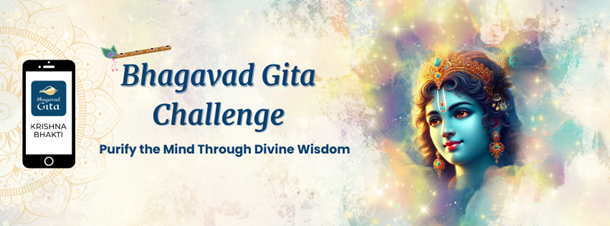
From the Editor’s Desk
In our fast-paced world, where instant gratification has become the norm, the virtue of patience often seems like a lost art. Yet, patience is a cornerstone of spiritual growth and personal development. This profound quality has the power to transform our lives, relationships, and the very fabric of our being.
Utilizing the Vedic knowledge (i.e., tattva jnana) taught by Swami Mukundananda ji, we explore the depths of patience and illumine ourselves with real-life examples in this issue of JKYog’s E-Journal, Samarpan. Given that the devotional festival of Ram Navami is approaching, we also note specific events that exemplify the patience of some of the key characters in the sacred epic Ramayan.
Vedic Wisdom & Application
Challenge of the Month
The Art of Patience: Cultivating Inner Strength
Reflection Questions
- What is Patience?
- Why is Patience Necessary for Spiritual Seekers?
- What are the Practical Strategies to Develop Patience?

At its core, patience is the ability to remain calm and composed in the face of delay, difficulty, or adversity. It is not merely passive waiting, but an active state of inner peace and acceptance.
What is Patience?
Our Vedic scriptures describe patience as a vital virtue that fosters spiritual growth. It is seen as the ability to endure difficulties and challenges without losing faith or becoming disheartened. Patience allows us to remain steadfast in our sadhana, helping us to cultivate a deeper connection with the divine. It teaches us to accept the divine timing of events in our lives, understanding that everything unfolds according to a higher plan.
Patience reflects our inner strength and spiritual maturity. For example, we learn from the life of Shree Ramakrishna Paramahans, the 19th-century saint, that despite severe physical ailments in his later years, he maintained unwavering patience and spiritual equanimity. His ability to endure pain without complaint and continue imparting wisdom to his disciples exemplifies the true essence of patience.
Patience also encompasses forbearance and tolerance. While forbearance is the ability to endure hardship, and tolerance is the acceptance of differing views or behaviors, patience goes further – it is an active state of inner calm and positive expectation. Mahatma Gandhi’s life beautifully illustrates this quality. His patience during India's freedom struggle was not mere tolerance of British rule or forbearance of hardships. It was an active, unwavering commitment to non-violence and truth, fueled by the conviction that justice would ultimately prevail.

The lives of saints teach us that patience is correlated with many other virtues including compassion, humility, perseverance, and equanimity.
Why is Patience Necessary for Spiritual Seekers?
Developing patience on the spiritual path and in life, in general, is necessary for several reasons that lead to inner transformation.
- Patience allows us to cultivate a deeper understanding of the divine timing in our lives. Just as a father rewards his diligent son for his hard work, God bestows grace upon those who qualify themselves through self-effort and surrender. If we lack patience, we may become disheartened or lose motivation, whether in the pursuit of material or spiritual goals. We will falsely believe that grace is granted whimsically.
- Patience is a virtue that helps us grow spiritually. It teaches us to endure challenges and develop qualities like humility and empathy, which are crucial for a successful life. By facing difficulties with patience, we learn to trust in God’s plan and timing, ultimately preparing ourselves to receive His grace. In essence, patience is not just about waiting; it is about actively engaging in our spiritual practice, understanding our role in qualifying for divine grace, and embracing the lessons that come our way. This approach enriches our spiritual growth and strengthens our connection with the divine.
- Practicing patience and maintaining a devotional attitude can help us develop saintly qualities over time. We must remember that even the greatest saints faced tribulations but remained steadfast in their devotion. By embracing these challenges as part of our spiritual journey, we can cultivate resilience and inner strength, ultimately leading to a deeper connection with the divine.
- Cultivating patience yields numerous benefits in our personal lives. It can reduce stress and anxiety associated with life's uncertainties and equip us to handle life's challenges with resilience. We tend to make better decisions when we think clearly. Patience can also heal rifts and deepen bonds over time, resulting in harmonious interactions.

- Patience also allows us to navigate challenging situations more effectively. For example, dealing with difficult people, facing repeated failures, waiting for the fulfillment of long-term goals including spiritual, and managing chronic health issues.
- Finally, patience also results in enabling us to transform the lives of others as well. For example, patient teachers often have the most profound impact on their students' lives. Major societal transformations often require years of patience and consistent effort as in the case of groundbreaking discoveries.
What are the Practical Strategies to Develop Patience?
We have heard the story of how Bhadrachala Ramadasu endured immense suffering during his imprisonment but remained steadfast in his devotion. He composed heartfelt kirtans expressing his anguish, longing, and unwavering faith in Lord Ram’s grace. His patience bore fruit when Shree Rama Himself appeared and repaid the debt in gold coins marked with His divine seal. Saint Ramadasu was then released, demonstrating how true devotion and patience eventually attract divine grace. His life teaches us that waiting for God’s grace is itself a test of devotion, and those who persevere are ultimately blessed.
Swamiji suggests several practical strategies to develop patience.
- Mindfulness: Stay present and aware of your thoughts and feelings, which helps in managing impatience. Mindful meditation helps to cultivate inner calm and awareness.
- Reflection: Regularly reflect on past experiences where patience led to positive outcomes, reinforcing its importance.
- Compassion and Gentleness: As we grow in patience, we naturally develop compassion for others and gentleness in our interactions, which further enhances our spiritual practice.
- Surrender: Trust in the divine will and surrender your worries, knowing that everything happens for a reason.
- Perspective Shifting: Try to see challenging situations as opportunities for growth.
- Deliberate Pausing: When feeling impatient, take a deep breath and pause before reacting. The short gap will enable you to choose a better response than to react negatively.
- Practice Gratitude: Focus on what you are grateful for to increase your patience.
- Set Realistic Expectations: Align your expectations with reality to reduce frustration.
Swamiji often shares the inspiring journey of how A.P.J. Abdul Kalam became India's "Missile Man" and the President of India despite his humble background. His patient pursuit of knowledge and unwavering dedication to his goals, despite numerous challenges, led to remarkable achievements in science and leadership.
Illustrations of Patience in the Ramayan
Patience was demonstrated by many key characters in the Ramayan, as they endured hardships, upheld righteousness, and waited for divine justice. Here are some specific events that exemplify their patience while waiting for outcomes:

1. Lord Ram’s 14-Year Exile – Patience in Adversity
- When Queen Kaikeyi demanded Shree Ram’s exile, He did not resist or express sorrow. Instead, He patiently accepted His father’s decree, understanding that dharma must prevail over personal emotions.
- For 14 long years, Shree Ram lived in the forest, facing hardships, but He never complained or acted impulsively.
2. Bharat’s Rule with Lord Ram’s Sandals – Patience in Loyalty
- Shree Bharat, though offered the throne, refused to rule as a king. Instead, he placed Lord Ram’s sandals on the throne and ruled as His caretaker, waiting patiently for Ram’s return.
- This demonstrates selfless leadership and unwavering patience, as he ruled righteously without seeking personal power.
3. Mother Sita’s Stay in Lanka – Patience in Faith
- When Ravan abducted Mother Sita and held her captive in Lanka, she never lost hope, demonstrating immense patience and unshakable faith in Lord Ram.
- Despite immense suffering, she never compromised her principles, waiting steadfastly for Lord Ram’s arrival instead of seeking an escape through any other means easily available to the Mother of the Universe.
4. Hanuman’s Search for Mother Sita – Patience in Service
- Bhakt Hanuman traveled across the ocean, searched Lanka thoroughly, and finally found Mother Sita. He could have immediately tried to rescue her, but he patiently followed his Lord’s mission instead of acting on impulse.
- His patience paid off when he was able to deliver Lord Ram’s message to Mother Sita and return successfully to share the information.
5. Vibhishan’s Defection – Patience in Righteousness
- Vibhishan, Ravan’s younger brother, endured severe ridicule and opposition in Lanka because he advised Ravan to surrender to Lord Ram after he unjustly abducted Mother Sita.
- When Ravan refused to listen, Vibhishan aligned himself with Lord Ram, even though it meant leaving his family and kingdom behind. He humbly surrendered and waited patiently without knowing whether the Lord would accept him.
6. The Vanar Sena Building the Bridge – Patience in Devotion
- Under the guidance of Nal and Neel, the Vanar Sena (i.e., the monkey army) patiently built the Rama Setu over the ocean, understanding that achieving a great goal requires perseverance and teamwork.
- They wrote Shree Ram’s name on the stones, demonstrating faith, patience, and devotion.
7. Lord Ram’s Battle Against Ravan – Patience in Strategy
- Instead of attacking impulsively, Shree Ram waited for the right moment and strategically weakened Ravan’s forces. Even though He was all-knowing, He asked Vibhishan’s advice on the strategy to kill Ravan.
- Even in battle, Shree Ram exhibited self-restraint, patience, and adherence to dharma, ensuring a righteous victory.
Each of these instances teaches us that patience is not passive waiting but an active demonstration of faith, righteousness, and perseverance. The Ramayan beautifully illustrates that those who wait patiently while upholding dharma ultimately attain divine success. To quote Swamiji, "Patience is not the ability to wait, but the ability to keep a good attitude while waiting."

Tools for Your Personal Growth
How patient are you when experiencing situations that test your endurance? Use this self-assessment tool to know. A downloadable tracking sheet is available for you to use.

Gems of Wisdom from Swamiji
Here are a few YouTube video titles with related links and books where Swamiji has described the virtues of patience for success in life.
- DON'T Wait for Tomorrow - NEVER Waste Time Wisdom from Ramayana and Mahabharata | Swami Mukundananda
- God's Invisible Hand That's ALWAYS Protecting you - The Miracles of Faith | Swami Mukundananda
- Mukundananda, S. (2024). Nourish Your Soul: Inspirations from and Lives of Great Saints. Rupa Publications Pvt Ltd: New Delhi, India.
- Mukundananda, S. (2024). Spiritual Secrets from Hinduism: Essence of the Vedic Scriptures. Rupa Publications Pvt Ltd: New Delhi, India.
- Mukundananda, S. (2023). The Art & Science of Happiness, Penguin Random House India: GuruGram, India.
- Mukundananda, S. (2022). The Power of Thoughts, Penguin Random House: Gurugram, India.
- Mukundananda, S. (2020). The Science of Mind Management, Westland Publications: Chennai, India.

Hold Your Breath: Upcoming Events
We are very excited to share two dynamite events with you!

JKYog’s Ram Navami Celebration: The Radha Krishna Temples of Dallas, Bay Area, and North Carolina
The celebration of the birth of Lord Shree Ram is always a joyous occasion regardless of the part of the country or world where people of Indian origin reside.
| Ram Navami at RKT Dallas with Swami Mukunananda | Ram Navami Mela & Holi at RKT Bay Area | Shree Ram Navami Mahotsav at RKT NC |
|
Devotees will celebrate Chaitra Navratri & Ram Navami festivities in the divine presence of Swami Mukundananda (April 5-6, 2025) including:
|
Devotees will celebrate Ram Navami Mela (April 5-6) with a variety of festivities including:
|
Devotees will have the opportunity to participate in many cultural celebrations (April 4 to 13) including the following highlights:
|
JKYog’s Bhakti Kirtan Retreat with Swamiji – April 18-20, 2025
Vedic scriptures and Bhakti Saints recommend kirtan as a tool for evoking devotion and love for God to purify the heart. In Kaliyug, Kirtan is especially recommended as the best form of Sadhana. We have the most wonderful opportunity to participate in a 3-day Bhakti Kirtan Retreat with Swamiji at the Radha Krishna Temple of Dallas.
- Break free from the cacophony of modern life to find inner peace and spiritual fulfillment in a peaceful and serene environment.
- Experience the harmonious blend of music, chanting, and contemplation that captivates the mind and keeps it engaged. Each verse and melody offer a different facet of divine expression, keeping our practice fresh and vibrant.
- Embark on a journey of self-discovery and spiritual elevation as you listen and meditate. Kirtans are more than mere musical compositions; they are portals to divine knowledge and wisdom embedded in the lyrics.
- Above all, soak in the bliss of listening to Swamiji’s chants and deeply divine and melodious kirtans that will transport you to a realm not easily experienced in the humdrum of material existence.
Details: https://www.radhakrishnatemple.net/bhakti-kirtan-retreat

JKYog Transforming Communities
Here, we share news about various JKYog centers and programs.
JKYog’s Swami Mukundananda Exclusive (SMEx)
Swami Mukundananda Exclusive is truly the most heart-warming and exclusive opportunity to connect one-on-one with Swamiji. This community of spiritual aspirants is exclusive in that people sign up for membership to connect with Swamiji live, and benefit from his knowledge and guidance. Despite Swamiji's extremely tight schedule, he so graciously takes time out to meet with all his devotees twice a month to discuss issues of great concern to people. New members continue to join regularly to connect with Swamiji.
Some meetings are scheduled exclusively for Q&A with devotees. With guidance from Swamiji, all members experience inner bliss and are very grateful for the opportunity to associate with a divine personality.
Sign up for membership to transform your life: SMEx website.

Bhagavad Gita Krishna Bhakti App in the Media

The Bhagavad Gita Krishna Bhakti App is making global waves! Prominent media outlets such as ANI, Business Standard, etc. covered the launch of the 21-Day Bhagavad Gita Challenge on the world’s first AI-powered Bhakti App, which brings the eternal wisdom of the Bhagavad Gita to individuals and families worldwide in an engaging and transformational way.
Read more about the coverage here.
Inspiring Stories of App Users:
"This app has profoundly enriched my life, equipping me with essential wisdom to navigate challenges confidently. Grateful for this divine journey of learning and growth!"
Watch the heart-touching experience of this young devotee whose life was transformed through the app.
Join the 100 K-strong community of worldwide devotees who trust the Bhagavad Gita Krishna Bhakti App for their spiritual and personal growth.
Download FREE on the App Store and Google Play: jkyog.org/app






